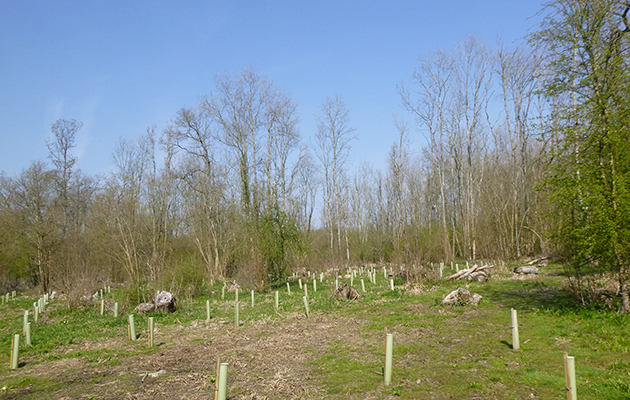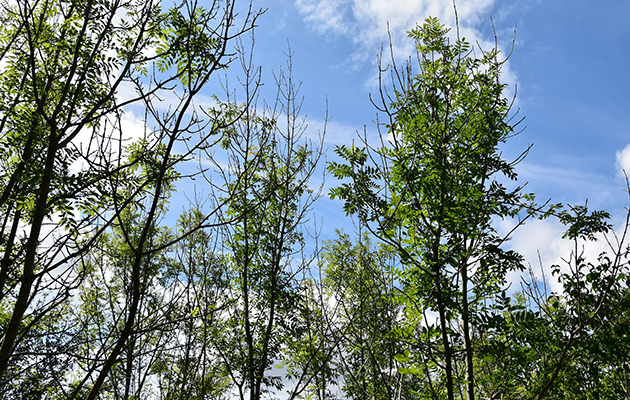This much-loved native species faces an uncertain future due to a relentless pathogen, says Simon Lloyd, which is damaging landscapes and wrecking our woodlands
Ash is the second most abundant tree in small woodlands after oak, used extensively by furniture makers and craftsmen, praised for the extensive biodiversity it can sustain and beloved by the nation. But now it is under threat due to a relentless pathogen, ash dieback. We must share knowledge and be open to new ideas, says Simon Lloyd, chief executive of the Royal Forestry Society.
For more on tending to your own garden, whether you want to start a veg patch or encourage more wildlife visitors, follow The Field’s guide to gardens.
ASH DIEBACK
Ash is one of those tree species that is much beloved by the nation – a national treasure. It has been nurtured for centuries by woodland owners and managers as a reliable timber crop. It is used extensively by furniture makers and craftsmen, praised by nature lovers for the extraordinary range of biodiversity it can sustain, and enjoyed by the public for its sheer aesthetic beauty and the grace it brings to any wooded landscape. However, the first indications that all was not well in our ash woodlands came in 2012 – just seven years ago. Ash dieback – a fungal pathogen initially known as ‘chalara’ but now recognised as Hymenoscyphus fraxineus – was reported on young trees imported into nursery stock from mainland Europe. That stock was quickly destroyed. But then came further discoveries and, although first reported in 2012, there is now strong evidence that ash dieback was present in the UK before that date, undetected.

Closer inspection reveals bark lesions.
Tracing the disease further back, it first emerged in Poland in the early 1990s and has spread through many European countries, killing ash trees in their millions – 90% of those in Denmark have died.
It is spread both on imported stock (now banned) and is carried by the wind. Since 2012, it has spread east to west across the UK, and can now be seen in almost every county of England and Wales and across Eastern Scotland. Young ash is particularly susceptible but in the past few years it has become obvious that older, mature ash is also falling victim.

Wilted ash leaves are signs of ash dieback.
The chances are you will have spotted it in roadside trees or woodland near you, which have been looking barer and browner than in previous years. The first visible signs in a tree is, as its name suggests, usually foliage dieback – but look closer and there are almost always diamond lesions on the bark and shrivelled, blackened shoots. Out of sight, the disease affects the tree’s vascular system, causing necrosis in the sapwood, affecting the tree’s ability to draw up nutrients. If ash dieback itself doesn’t kill, the tree will be weakened allowing other disease in – such as honey fungus – to finish it off.
The progress of ash dieback in each tree tends to be quick, with timber quality degrading – becoming brittle and structurally unsound – and death of the tree within a couple years. The pathogen reproduces as tiny, mushroom-like fruiting bodies on fallen leaves and stalks, which then spread as spores on the wind.

Oak is planted following the felling of diseased ash trees.
As ash dieback continues its relentless – and currently unstoppable – spread we are facing the prospect of the loss of the vast majority of existing ash trees. Research suggests just 1% to 5% of ash trees may prove genetically tolerant although there is some evidence that UK ash may have greater tolerance than in continental Europe. The race is on – led by Forest Research and the Future Trees Trust – to identify, develop and breed genetically resilient trees.
However, if they are successful it will be some years before new, resilient ash trees are available to be planted and four or more decades before they are mature.
LIMITED OPTIONS
There is no known cure for ash dieback and limited preventative options. Biosecurity measures include spraying boots and equipment before entering a wood and collecting fallen leaves and burning them. These measures are not foolproof and only feasible and practicable where there is limited and controllable access to the woodland. Collection of leaf fall would only ever be possible for small, isolated clumps and is unrealistic for all but the very tiniest of woodland.
Ash is the second most abundant tree found in small woodlands after oak. Faced then with the loss for a number of decades of one of the mainstay species of our woodland, there is no doubt there will be a noticeable impact on the landscapes where the percentage of ash is high.

Ash coppice woodland is also under threat.
What can woodland owners and managers do? There is no one correct answer. How woodland is managed will be down to the owner/manager’s objectives. The exception is managing safety, which is obligatory and must take precedence. Selective thinning, pre-emptive thinning and wait-and-see approaches can all be valid responses. Where ash is taken out, however, there is an opportunity to replace it with a wider mix of tree species that will build a woodland’s resilience to climate change and therefore its chance of flourishing.
Sadly, ash is not the only species facing challenges: mature oak – that iconic tree – is susceptible to Acute Oak Decline as well as damage by grey squirrels; beech is unlikely to survive severe drought periods under predicted climate change; blight is affecting sweet chestnuts; Dutch elm disease has already robbed us of most of our elm; Phytophthora ramorum has reaped havoc across larch plantations. The list goes on: known threats including the emerald ash borer and the mountain pine beetle in North America, which have yet to hit our shores, and then there are the unknowns – the future ‘ash diebacks’ that no one has yet predicted.

Affected ash is felled along roadsides for safety.
All of which means that we need to think ahead when we are planting or replanting to build woodland that can be truly resilient. Advice from the Forestry Commission in building resilient woodland is to diversify risk by planting a wider mix of species, including natives such as the wild service tree and small leafed lime, which are generally less represented in our woodland than they might be. Other options are to increase genetic diversity by introducing trees from between two degrees to five degrees latitude south (about 140 to 350 miles south of your location) and to introduce some non-native trees into the mix, including black walnut, eucalyptus, Italian alder, southern beech and conifers such as Japanese red cedar and redwoods, which are potentially suitable for our changing climate.

Classic Canes’ 2018 ash stick harvest was unaffected, but ash dieback threatens future ash harvests.
Replanting choices will be influenced by management priorities, soil, topological and other environmental considerations. Not all trees are suitable for all sites. For those whose woodland priority is conservation, ash will be a particular loss. Forest Research project manager Alice Broome revealed in an article published by the RFS in its October 2014 Quarterly Journal of Forestry that ash hosts more associated species than any other woodland broadleaved tree – 955 species of birds, mammals, lichens and insects. Many of the alternative species are among those we have mentioned as facing challenges. Broome ranked oak (640), beech (505), elm (477) and hazel (430) as second, third and fourth respectively among native species for the number of associated species. Among non-native species, sycamore ranked highest with 473 associated species, followed by horse chestnut (208), European larch (166) and common walnut (149).
THE ROYAL FORESTRY SOCIETY
What to do about ash dieback is a question we have been addressing in the Royal Forestry Society’s own woodlands and with other woodland owners. The RFS Battram Wood is a young site within the National Forest in Leicestershire planted on former agricultural land between 1998 to 2000. Ash dieback was first spotted in 2014/15. The management objective there is to provide an example of professional management and silviculture to create best-quality timber. It was decided to fell 75% of the young ash before ash dieback became too well established. Felling in small coupe areas, developing glades was an opportunity to restock and to introduce age diversity as the wood matures. Restock species agreed under the Felling Licence include wild cherry, silver birch, black walnut, Douglas fir, pedunculate oak, hawthorn and hazel with the aid of a Countryside Stewardship Woodland Tree Health Grant. We will continue to monitor the remaining ash.

Thinning taking place at RFS Hockeridge Wood.
At the well-established RFS Hockeridge Wood near the Chilterns, the challenges and objectives were different and the proportions of ash low. This is a woodland that had been home to a thriving timber industry in the 19th and early 20th centuries. Here we selectively thinned affected trees within the ash/sycamore/hazel mix. Around 15% of trees were removed to provide more space and airflow for the most healthy ash to continue to grow in the hope that some show resistance to ash dieback. The thinning is also allowing more light to the woodland floor, helping to encourage woodland flora for which the wood is well known. We are monitoring the remaining ash in the wood and are anticipating more thinning, especially along road boundaries where affected ash trees could pose a safety risk.
To provide practical advice, we joined forces with the Forestry Commission to produce 10 case studies from woodland throughout England, all facing differing challenges. These include: Classic Canes’ ash coppice woodland growing walking sticks; a contractor who brought together three woodland owners beside a B road to fell along the road and make it safe; and a site managed for the MoD where safe access for troops is vital. Other case studies feature woodland in Areas of Outstanding Natural Beauty (AONB), where landscape aesthetics considerations are paramount, and those with designations such as Site of Special Scientific Interest (SSSI) or Plantations on Ancient Woodlands (PAWS), which have specific planting requirements. All these case studies are available at rfs.org.uk with contact details for further information for each site. Further information on ash dieback is also readily available through the Forest Research web pages.

Some of Classic Canes’ canes.
As ash dieback continues to spread, specially trained teams of arborists and contractors will be needed to fell safely. In the coming years, expect to see and hear significantly more selective thinning, pre-emptive thinning and safety felling alongside roads, rail lines and areas of public access where brittle trees are at risk of falling.
Sharing knowledge about ash dieback is vital. Being open to new management ideas will help ensure some good emerges. Even if future woodlands look subtly different, we need to ensure they remain productive, providing timber grown in the UK, rich ecological habitats with thriving biodiversity and the many benefits associated with carbon capture and flood attenuation, health and wellbeing – a landscape of which we and future generations can be proud.
Simon Lloyd is the chief executive of the Royal Forestry Society





